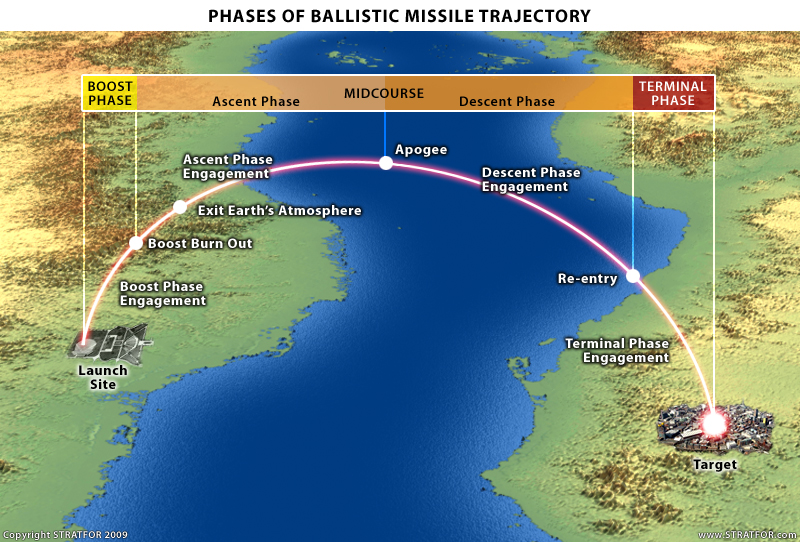Agni-V IRBM
The canisterized intermediate range nuclear capable Agni-V missile is also referred to as Agni-III+
The Indian Government sanctioned Rs2,500 crore to develop the Agni V missile, with a range of 5,000km in 2008. The missile is expected to be ready for testing in the 2010-11 time frame.
At a Glance
Range 5,000 km
Stages Three
Warhead Weight 1.5 ton
Warhead Type Single, MIRV warheads under development.
Total Weight 51 ton
Dimensions 22m long, 2m diameter
Status Design completed. First Test - Early 2011
Introduction
The Indian Government sanctioned Rs2,500 crore to develop the Agni V missile, with a range of 5,000km in 2008. (The Agni V is also referred to as Agni III+).
The missile is being developed by adding an all composite third state to the two-stage, 3, 500km Agni III missile.
The missile will have 60% commonality of components with Agni III, including its ring laser gyroscope and accelerometer.
The gyroscope was developed by Research Centre Imarat (RCI), sister laboratory of ASL, and is part of DRDO's missile complex in Hyderabad.
The ring laser is also fitted on the Shourya tactical missile.
Navigation System
Agni-V uses the same navigation system as the one fitted on Agni-III.
It uses a ring laser gyroscope that was developed by Research Centre Imarat (RCI), sister laboratory of ASL, a part of DRDO's missile complex in Hyderabad.
The ring laser is also fitted on the Shourya tactical missile.
Canistered Missile
It will be canistered missile allowing for launch from multiple platforms.
Operational Status
The design of the missile has been completed. Subsystem testing and material cutting was in progress as on February 10, 2010.
The missile is expected to be ready for testing in the 2010-11 time frame.
Speaking to the press on February 10, scientific advisor to defence minister V.K. Saraswat said:
"Agni-V has crossed material cutting stage and subsystem testing is going on. Agni-V is derivative of Agni-III. Practically it is the same missile but it is five metres longer and one tonne heavier. Its navigation system is same.
"Sixty percent missile is available and we are just adding another stage. It will be a three-stage missile and it is the first time we will be building a three-stage missile."
Use of Composites
Besides the all composite third stage, the second stage of the missile will also use composites to save weight and allow for the addition of a third stage.
Talking to The Hindu in November, Avinash Chander, director of the Agni program and of the Advanced Systems Laboratory (ASL) said the Agni V design has been completed and the first development flight test will be conducted in 2010.
MIRV Warheads
VK Saraswat, DRDO's Chief Controller of Missiles and Strategic Systems, told Business Standard in May 2008 that DRDO is working on a 5,000kme range Agni-5 missile, with multiple warheads (MIRVs) that can maneuver and send out decoys to confuse enemy anti-missile defenses.
In October 2008, ASL Director Avinash Chander told Business Standard:
We have made major progress on the MIRVs in the last two years.
MIRV technology is very similar to the multiple satellite launch technology that ISRO has mastered and repeatedly demonstrated using its PSLV launcher. However, warhead separation requires a higher degree of accuracy than satellite separation. MIRV is effective only when accuracy of the individual warheads is high, allowing relatively small warheads to be targeted at widely dispersed targets.
MIRVed missiles deployed on nuclear submarines represent a potent second strike capability in support of a no first use nuclear doctrine like the one embraced by India.
Canister Launch
The mobile missile will be the first Indian strategic missile capable of canister launch, allowing it to be deployed and launched from any part of the country. A canister launch capability is also compatible with reports that the missile will ultimately equip India's newly launched nuclear powered submarine - INS Arihant.
Placing the missile in a hermetically sealed canister facilitates long term storage. The missile canister is made of maraging steel allowing it to withstand the 300 to 400 t shock generated when the 50-ton missile.is ejected out.
All future missiles will be canister based ASL Director Avinash Chander told Business Standard in October 2009,
The Agni-5 is specially tailored for road-mobility, explains Avinash Chander, Director, ASL. With the canister having been successfully developed, all Indias future land-based strategic missiles will be canisterised as well.
Canister technology was initially developed for the naval variant of Brahmos missile. The technology was completely mastered during the development of the K-15 missiles that will initially equip INS Arihant.
Agni-V IRBM - a knol by Vijainder K Thakur















